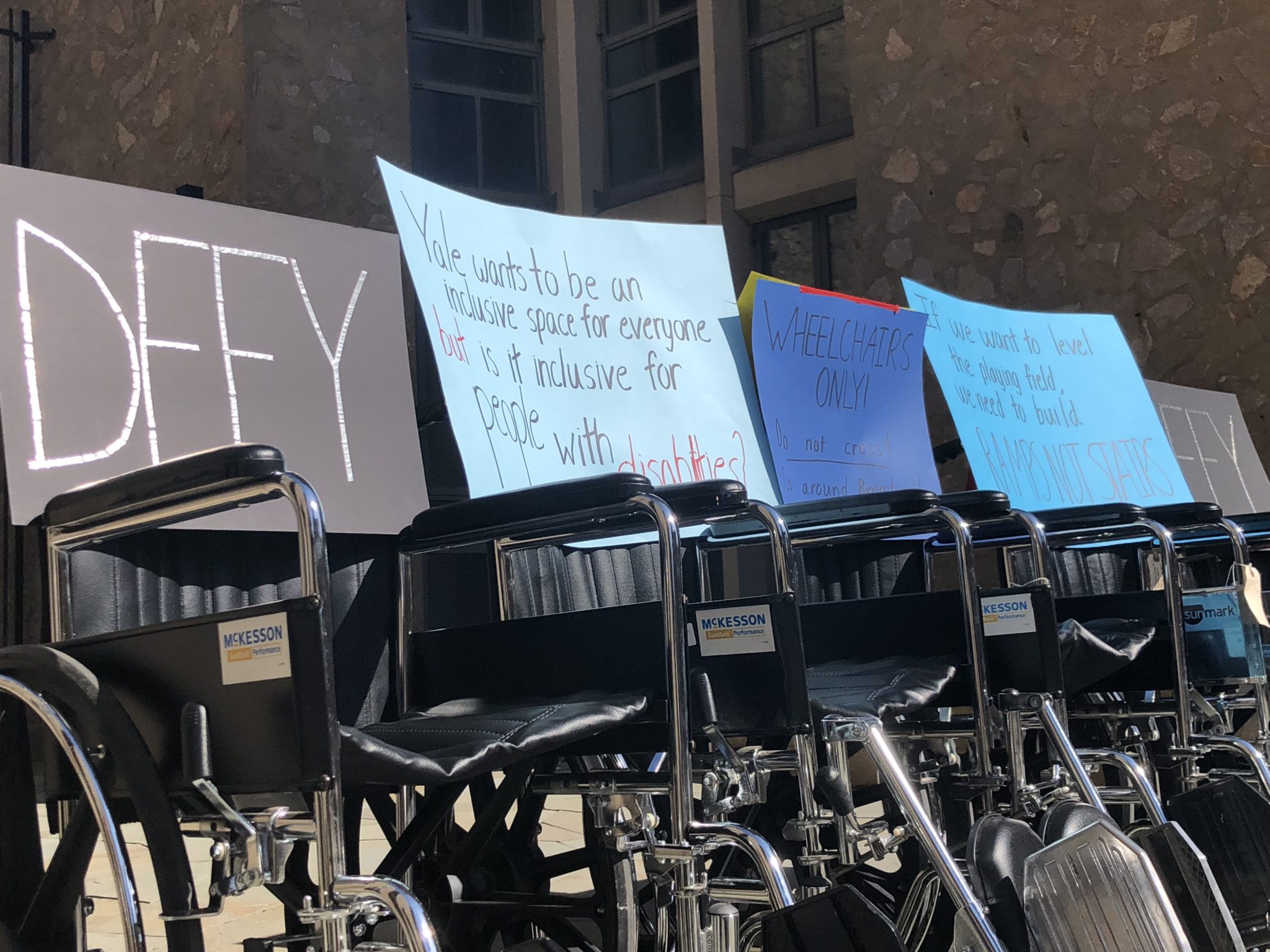
Brennan Carmen
Students from Disability Empowerment for Yale, or DEFY, put up a display of wheelchairs and signs in the Morse College courtyard on Wednesday morning to protest the lack of wheelchair access along the Morse–Stiles walkway — which leads to the Payne Whitney Gym — and in other Yale locations, continue reading this to learn more.
The display comprised a number of wheelchairs holding signs that read “Ramps Not Stairs” and questioned whether Yale is “inclusive for people with disabilities.” The Morse-Ezra Stiles colleges walkway, which has a number of stairways but no ramps, is a high-traffic area on campus that offers students a convenient path from the York Street side of Morse and Ezra Stiles to the Payne Whitney Gym area. For students with injuries or disabilities who cannot use stairs, the route to Payne Whitney requires a longer trip down either Tower Parkway around both the Hall of Graduate Studies and Morse or down Broadway, past the Shops at Yale and then past Stiles. Ben Nadolsky ’18, who is president of DEFY and a wheelchair user, said that while many residential colleges suffer from dated layouts that do not take wheelchair access into account, DEFY wanted to highlight the importance of this specific pathway.
“The best manifestation of the issue comes through in the Morse–Stiles walkway. It’s used so frequently especially for student-athletes, but it’s also used during Bulldog days and other major processions, and if you can’t use it you have to all the way around and be cast out from the group,” said Nadolsky. “And in that sense it’s very disheartening. I wouldn’t want a pre-frosh coming in and thinking, ‘Oh, they don’t really want me here because I can’t really proceed with them.’”
Last year the YCC Task Force on Disability Resources — which was chaired by Nadolsky — recommended that Yale review the use of inaccessible pathways at official Yale events and create a long-term plan for universal physical accessibility under the guidelines of the Provost Advisory Committee on Resources for Students and Employees with Disabilities, which is appointed by the provost each year to report on the needs of students and Yale employees with disabilities.
The Americans with Disabilities Act, passed in 1991 by the U.S. Congress, ruled that owners of spaces of public accommodation cannot discriminate against individuals on the basis of disability, and so, spaces open to the public must comply with wheelchair accessibility regulations. Because the Payne Whitney Gym area is accessible by wheelchair via longer alternate routes, it is technically compliant with the ADA. But Nadolsky said that the Yale administration should hold itself to a higher standard.
Dean of Yale College Marvin Chun said that, while the new facilities in Pauli Murray and Benjamin Franklin colleges were consciously designed with physical accessibility in mind, older Yale facilities were not constructed to account for the same concerns and are generally less accessible for mobility-impaired students.
“Accessibility is always a high priority for Yale. Whenever a new project happens, it is done with conformity as a top priority,” Chun said. “[The Morse-Stiles walkway] would be a good location to prioritize for accessibility conversion because … obviously there are chronically disabled students, but a lot of students who meet disability requirements are injuries from sports, so the fact that’s it right in front of the gym also makes it important.”
Nadolsky said he is the only undergraduate student who uses a wheelchair, and he estimated that there are five wheelchair users who study or work at Yale.
Still, he cautioned against giving any weight to the argument that the administration should not invest more in wheelchair accessibility until more mobility impaired people come to Yale. As long as Yale has serious problems with wheelchair accessibility, he explained, people with mobility impairments are unlikely to come to the University in the first place.
“It’s just feeding back into the problem,” Nadolsky said. “You’re putting a price on someone’s life and abilities if you say, ‘you’re not worth a ramp.’”
Nadolsky recalled heading toward Payne Whitney Gym for the extracurricular fair during Bulldog Days with a crowd of pre-frosh and realizing he could not continue on through the Morse-Stiles walkway with everyone else. Brennan Carman ’20, a member of DEFY, remarked that he did not realize the extent of Yale’s physical accessibility problems until his brother, who uses a wheelchair, visited him on campus.
Nadolsky said that Yale has done a “good job” making classrooms largely accessible to wheelchair users and installing Certified Stairlifts but that the University still needs to work on wheelchair accessibility in many of the residential colleges, as well as at the entrance to Commons Dining Hall, which is now under construction.
In an email to the News, Stiles Head of College Stephen Pitti, who was traveling on Wednesday and has not yet seen the exhibit, said that “it is important for all members of the University committee to keep issues of accessibility at the front of our minds.”
Yale’s Resource Office on Disabilities was founded in 1982.
Britton O’Daly | britton.odaly@yale.edu








